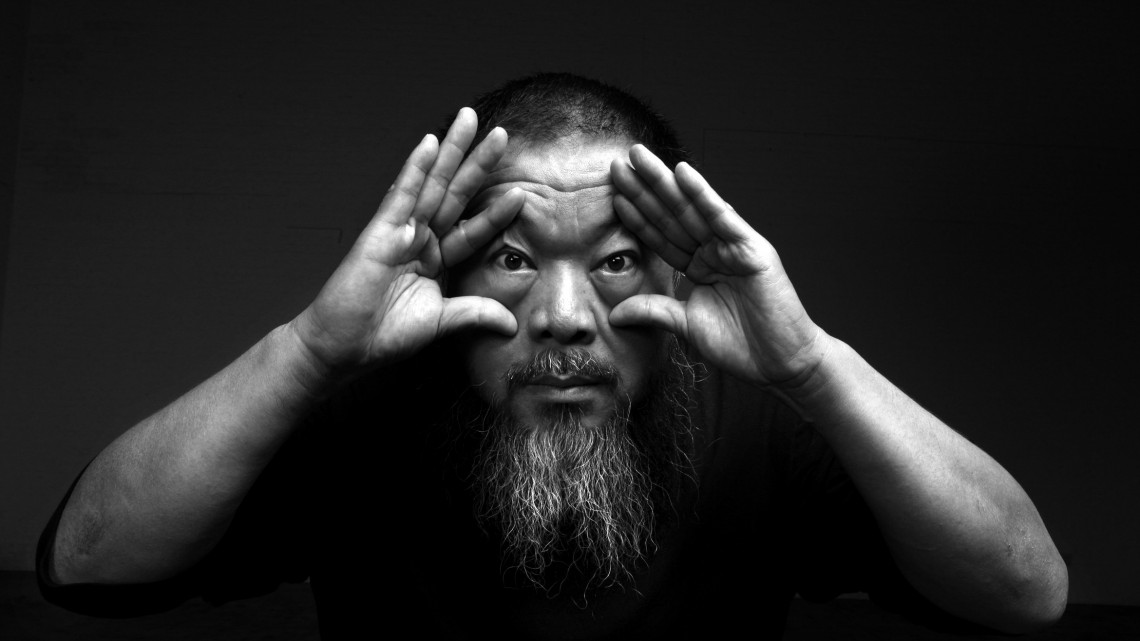“The misconception of totalitarianism is that freedom can be imprisoned. This is not the case. When you constrain freedom, freedom will take flight and land on a windowsill.” Ai Weiwei1
This September the work of Chinese artist Ai Weiwei will be installed on Alcatraz Island in San Francisco Bay. This venue would be remarkable for almost any living artist, based on scale and visibility alone. Yet for Ai, the opportunity to situate his politically charged art in the confines of a former United States federal penitentiary also resonates with his experiences of imprisonment in China as a dissident artist.
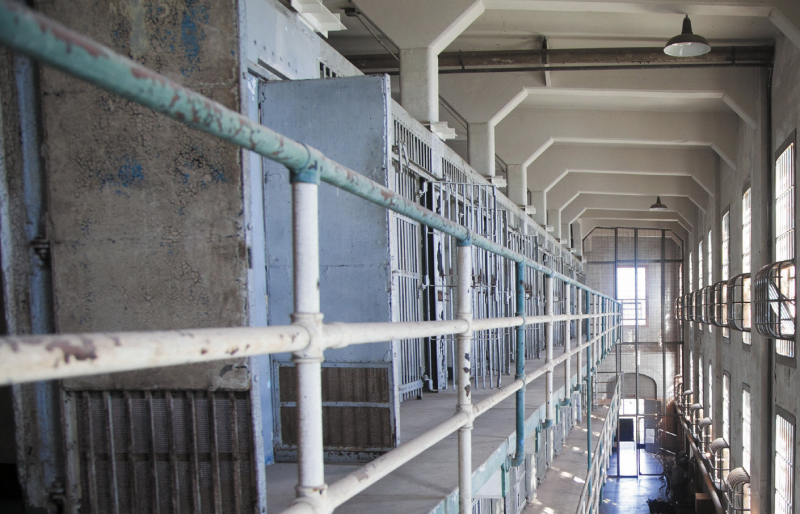
Second and third floors of A Block in the cell house at Alcatraz, site of the exhibition @Large: Ai Weiwei on Alcatraz. Photograph by Jan Sturmann. Courtesy of FOR-SITE Foundation.
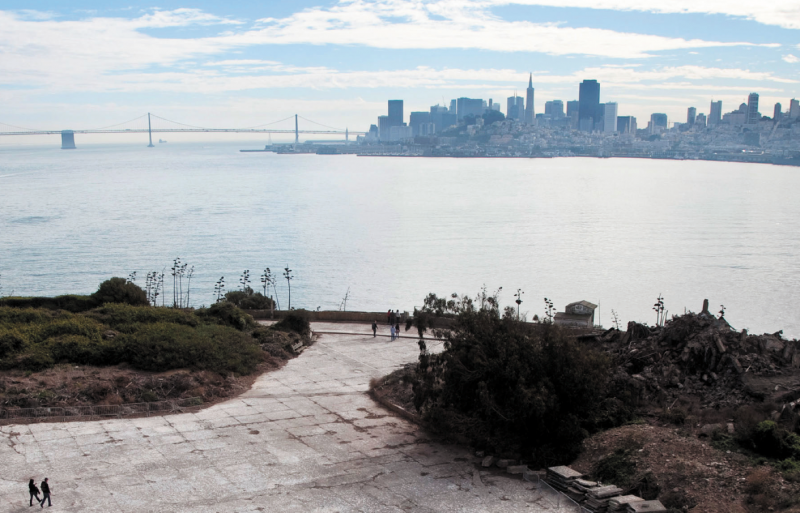
View of San Francisco from Alcatraz Island, site of the exhibition @Large: Ai Weiwei on Alcatraz. Photograph by Jan Sturmann. Courtesy of FOR-SITE Foundation.
The timing for the exhibition of this artist’s work on the site of a historic federal prison-cum-national park also speaks volumes about the For-Site Foundation—the project’s sponsor, in cooperation with the National Park Service and the Golden Gate National Parks Conservancy—and their ability to allude to such a highly charged situation on a well-attended government site. Although such ambitious projects involve years of planning and fundraising (in this case done entirely by the For-Site Foundation) the plan to open @Large: Ai Weiwei on Alcatraz also coincides with escalating economic and political tensions between the two countries. Compounding this has been China’s history of human rights violations, which have increased since 2011. As noted in Human Rights Watch World Report, 2012, “The government launched the largest crackdown on human rights lawyers, activists, and critics in a decade. The authorities also strengthened Internet and press censorship, put the activities of many dissidents and critics under surveillance, restricted their activities, and took the unprecedented step of rounding up over 30 of the most outspoken critics and ‘disappearing’ them for weeks.”2
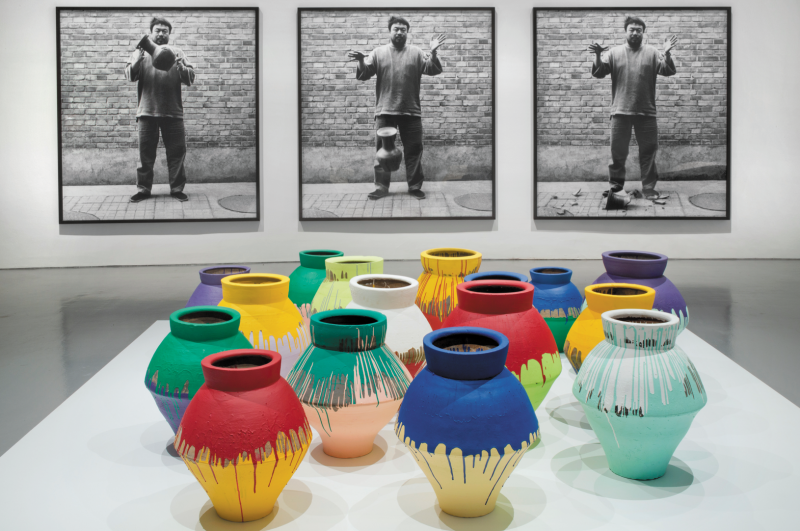
Ai Weiwei, “Colored Vases,” 2007‒10. Han Dynasty vases and industrial paint, dimensions variable. Courtesy of Ai Weiwei Studio. Installation view of Ai Weiwei: According to What? at the Hirshhorn Museum and Sculpture Garden, Washington D.C., 2012. Photograph by Cathy Carver.
Ai Weiwei was among those “rounded up” artists, writers, lawyers, critics, and activists, and was incarcerated for 81 days in 2011 on charges of tax evasion. A key member of the first group of avant-garde artists that emerged in China during the late 1970s, Ai has been an outspoken critic of the Chinese government for more than 30 years. His political activism is renowned and has been expressed through his remarkable bodies of artwork and actions. Despite his confinement in China since 2011, he has been well represented in recent museum exhibitions around the world that include According to What? organized by the Mori Art Museum, Tokyo, which will conclude its multi-venue U.S. tour at the Brooklyn Museum in August 2014. In addition, several books, a play (#aiww: The Arrest of Ai Weiwei, Hampstead Theatre, London, 2013), and a film (Ai Weiwei: Never Sorry, 2013) have reinforced knowledge of Ai’s art, life, and renown. With his political activity, arrest, and incarceration at the center of these projects, it follows that the installation of Ai’s Alcatraz project would conceivably highlight the related circumstances of his incarceration in China. Or at least on the surface this seems plausible.
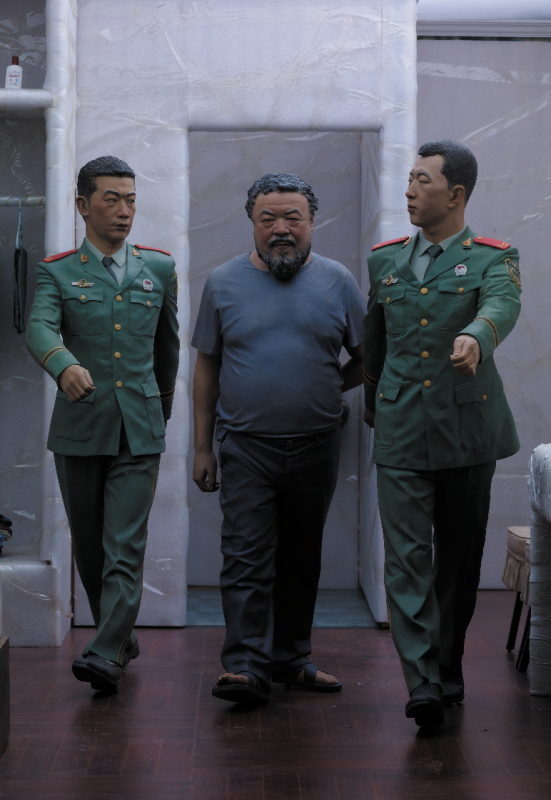
Ai Weiwei, “Ritual (detail),” 2011-2013. From the work S.A.C.R.E.D., 2011-13. One of six dioramas in fiber- glass and iron, 148 3/8 x 78 x 60 1/5 in. Courtesy of Ai Weiwei Studio. © Ai Weiwei.
Yet, this obvious connection is probably too simplistic for such a complex artist and his state circumstances. Moreover, According to What? (which I saw at the Brooklyn Museum of Art) featured an installation of S.A.C.R.E.D. (2013), a series of six dioramas, which Ai created in response to his detention. Intended to correspond with the details of his daily life in prison, the acronym for the six sculptures alludes to their content—Supper, Accusers, Cleansing, Ritual, Entropy, and Doubt—as well as ritual and religious ideas. The experience of each diorama is structured to create a voyeuristic relationship between viewer and artist, as we are compelled to stand on a box placed at the base of the steel rectangles in order to look down through a window atop each one to view the sculpturally recreated scenes of Ai’s activities within. The scenes are detailed down to his toilet, shower, meals, and ever-present guards, and set the tone for viewers’ experiences of the comprehensive show, which filled two upper floors of the museum.
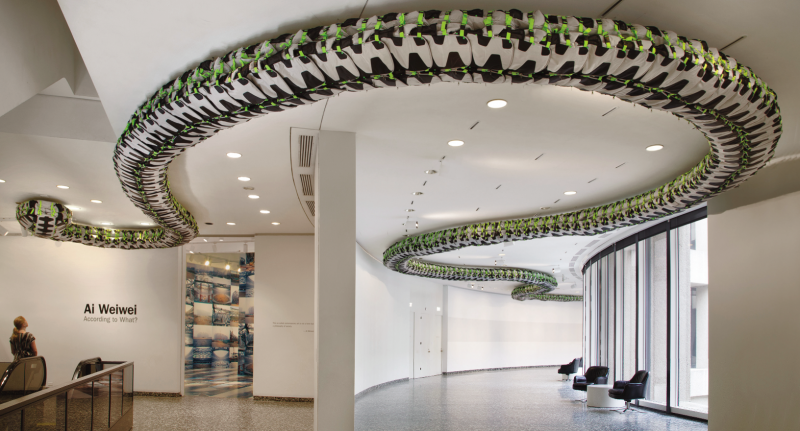
Ai Weiwei, “Snake Ceiling,” 2009. Back packs, 15 3/4 x 354 5/16 in. (40 x 900 cm). Collection of Larry Warsh. Installation view of Ai Weiwei: According to What? at the Hirshhorn Museum and Sculpture Garden, Washington D.C., 2012. Photo by Cathy Carver.
According to What? provides a fine overview of the depth and breadth of Ai’s oeuvre, including its sources, as well as insights into the artwork and actions that led to his incarceration. Ai’s sculpture–ranging from various handsome wood sculptures (2005–12), repurposed from dismantled Qing Dynasty temples (1604–1911); to his series of Colored Vases (2007- 10), created by dipping Han Dynasty vessels (206 BCE–220 CE) into bright paint; along with his photographic series Dropping a Han Dynasty Urn (1995-2009)—embody his confrontational relationship with the meanings embedded in Chinese cultural identity and traditions. He also has consistently employed monumental repetition to represent the enormity and gravity of social and cultural situations—here the magnitude and aftermath of the Sichuan earthquake stand out, with works that memorialize the outcome of poor building construction. These include Straight (2008–11), comprised of 75 tons of steel rebar collected from collapsed schools and other buildings, straightened and laid out like a minimalist sculpture; Snake Ceiling (2009), an unnerving, ceiling mounted serpent created with more than 5000 backpacks to represent students that perished; and Sichuan Namelist (2008-11), a gallery where walls are filled, a la Hanne Darboven, with the names of the deceased youth. Ai’s stance speaks to fundamental philosophical ideas concerning the rights and safety of individuals and society that are understood in the West, and confront the authoritarian powers that Ai and others have challenged with such work. Case in point: in 2009, during this period of documenting his findings from the Sichuan earthquake, police ostensibly beat Ai, which resulted in a cerebral hemorrhage that required emergency surgery.

Ai Weiwei, “Straight,” 2008–12. Steel reinforcing bars, dimensions variable. © Ai Weiwei.
So what might the Alcatraz project add to the discussion of Ai’s imprisonment and wrongful mistreatment by Chinese government officials? The equation between the history of Alcatraz and the artist’s imprisonment, subsequent confinement to Beijing for one year, and passport confiscation (which has made it impossible for him to leave China) has only a symbolic relationship that will be lost on much of the general public. Yet, regardless of what Ai Weiwei creates for this site—which the show’s organizers have kept a secret except to state, “(Will) explore urgent questions about human rights and freedom of expression and responds to the potent and layered history of Alcatraz as a place of detainment and protest”3—his creative production will be contextualized and immortalized for viewers by its installation on and in this infamous island and prison.
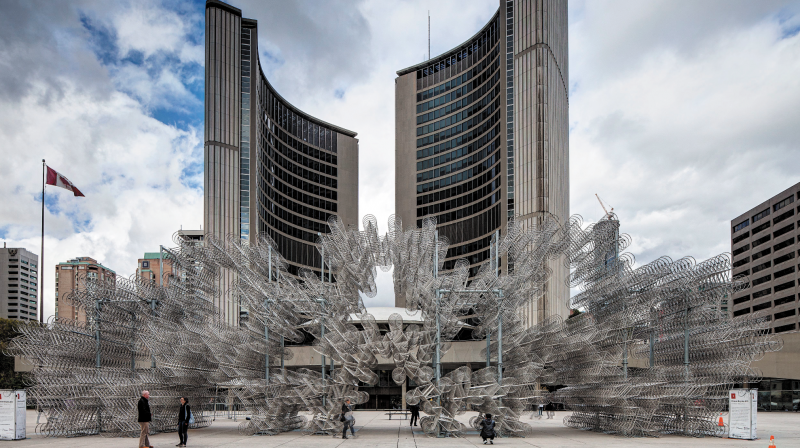
Ai Weiwei, “Forever Bicycles,” 2013. 3144 bicycles. Installation at Scotiabank Nuit Blanche 2013, Nathan Philips Square, Toronto, Canada. © Ai Weiwei. Photograph by John Heineman.
This begs the question of whether the project is solely about Ai Weiwei, who some regard as one of the most powerful contemporary artists alive. Rather, does the artist’s tendency to “hold up a mirror both to China’s failings and potential”4 make him a hero representative of the West’s contentious relationship with modern China? Will this project become a media spectacle that allows the U.S. to use its stance on artistic freedom to challenge repressive Chinese politics? Or, as Hou Hanru states in his letter to Hans Ulrich Obrist, (in which the two corresponded on the period of turbulence and emergency in spring and summer 2011 regarding various international matters, among them Arab Spring and the arrest of Ai Weiwei), “Under the pretext of defending human rights and freedom, the West regularly supports political dissidents as bargaining chips in negotiating with the autocratic powers over economic and geopolitical interests.”5 Although this may sound cynical, with the support of U.S. government agencies for this project, this possibility must be considered in the speculative mix. Yet, through my reflections on the politics, power, and potential of @Large: Ai Weiwei on Alcatraz, the “@ with wings” logo that graces For-Site Foundation’s press release also evoked more poetic ideas concerning flight, freedom, and incarceration that pertain to Ai Weiwei’s life, philosophies, and art. On one level, this logo alludes to Ai’s belief that “The Internet is uncontrollable, and if the Internet is uncontrollable freedom will win. It’s as simple as that.”6 On a deeper plane, in China the concept that freedom cannot be imprisoned is symbolized by the relationship of men to their birds. Since the Qing Dynasty, men have taken their birds out for morning walks. This practice expresses their concern that birds will lose their song if not kept happy. The argument is that taking a bird for a walk is the best way to keep it healthy and vigorous. As the men arrive at parks and gardens, they hang the cages in trees, allowing the birds to sing and communicate with each other while their owners practice t’ai chi ch’uan, play cards or chess, and talk.

Ai Weiwei, Williamsburg, Brooklyn, 1983. Courtesy of Ai Weiwei Studio. © Ai Weiwei.
It is likely that this custom is not lost on Ai, as its metaphors speak clearly of his personal situation. While Ai Weiwei is confined to his own “cage,” he continues to pursue the many activities of his daily life as an artist, actively “tweeting” via social networking media to reach thousands of people around the world. By extension, while the installations on Alcatraz (trans: the island of the pelicans) will provide a glimpse into the role that imprisonment has played in Ai Weiwei’s art and life, as a “caged bird” he also becomes a potent symbol of the indomitability of creativity and the human spirit. The uplifting words of Caged Bird come to mind:
The caged bird sings
with a fearful trill
of things unknown
but longed for still
and his tune is heard
on the distant hill
for the caged bird
sings of freedom.7
1) From multiple sources, as stated to Cheryl Haines by Ai Weiwei during her visit to China, 2013.
2) http://www.hrw.org/world-report-2012/world-report-2012-china. World Report 2012: China Events of 2011
3) Press Release, Ai Weiwei on Alcatraz, For Site Foundation, 2014.
4) Smithsonian.com, Mark Stevens, “Is Ai Weiwei China’s Most Dangerous Man?” www.smithsonianmag.com/ arts-culture/is-ai-weiwei-chinas-most-dangerous-man-17989316/?all . September 2012.
5) Hou Hanru, “Urgent is to Take a Distance,” Art Practical 2.20, June 29, 2011.
6) Rebecca Huval, “Ai Weiwei Sparks Social Media Flames in China.” Independent Lens Blog, http://pbs.org/inde- pendentlens/blog/ai-weiwei-sparks-a-social-media-fire-in-china. February 22, 2013.
7) Maya Angelou, “Caged Bird” from Shaker, Why Don’t You Sing? Copyright © 1983 by Maya Angelou. http://www. poetryfoundation.org/poem/178948
